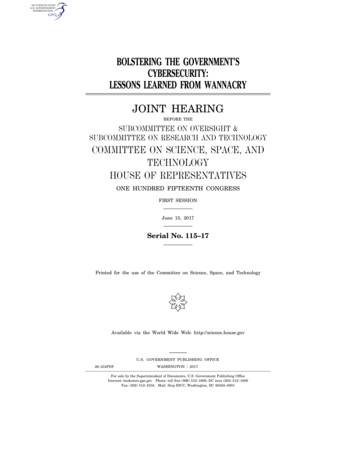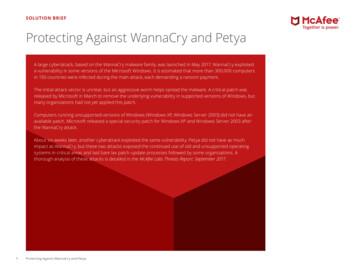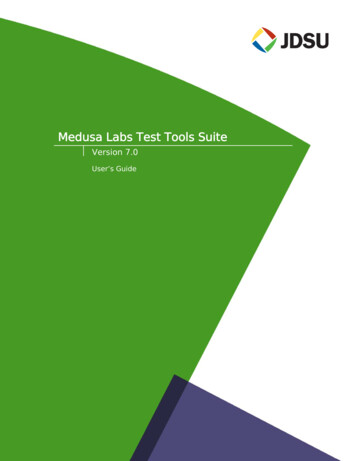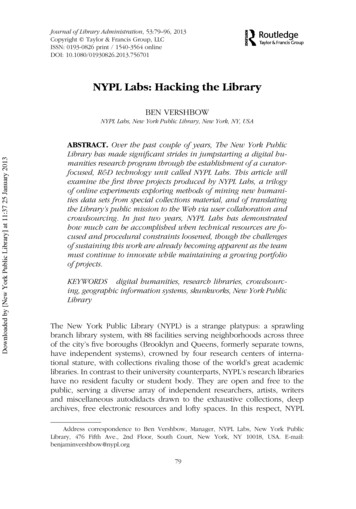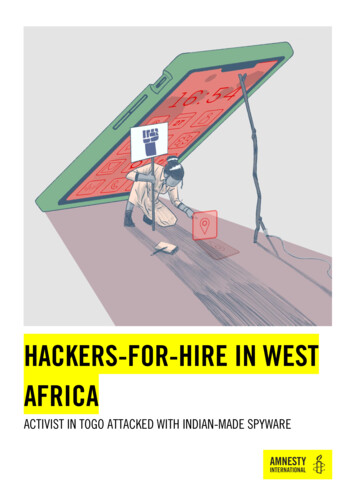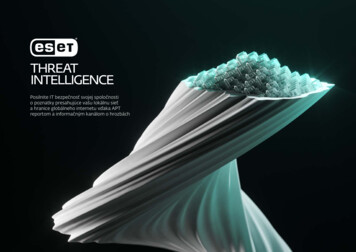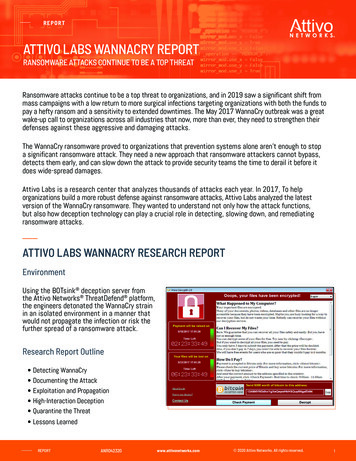
Transcription
REPORTATTIVO LABS WANNACRY REPORTRANSOMWARE ATTACKS CONTINUE TO BE A TOP THREATRansomware attacks continue to be a top threat to organizations, and in 2019 saw a significant shift frommass campaigns with a low return to more surgical infections targeting organizations with both the funds topay a hefty ransom and a sensitivity to extended downtimes. The May 2017 WannaCry outbreak was a greatwake-up call to organizations across all industries that now, more than ever, they need to strengthen theirdefenses against these aggressive and damaging attacks.The WannaCry ransomware proved to organizations that prevention systems alone aren’t enough to stopa significant ransomware attack. They need a new approach that ransomware attackers cannot bypass,detects them early, and can slow down the attack to provide security teams the time to derail it before itdoes wide-spread damages.Attivo Labs is a research center that analyzes thousands of attacks each year. In 2017, To helporganizations build a more robust defense against ransomware attacks, Attivo Labs analyzed the latestversion of the WannaCry ransomware. They wanted to understand not only how the attack functions,but also how deception technology can play a crucial role in detecting, slowing down, and remediatingransomware attacks.ATTIVO LABS WANNACRY RESEARCH REPORTEnvironmentUsing the BOTsink deception server fromthe Attivo Networks ThreatDefend platform,the engineers detonated the WannaCry strainin an isolated environment in a manner thatwould not propagate the infection or risk thefurther spread of a ransomware attack.Research Report Outline Detecting WannaCry Documenting the Attack Exploitation and Propagation High-Interaction Deception Quarantine the Threat Lessons LearnedREPORTANR042320www.attivonetworks.com 2020 Attivo Networks. All rights reserved.1
DETECTING WANNACRYThe BOTsink deception server observed the WannaCry ransomware conducting an initial scan of the local SMBports on the subnet. The ransomware exhibited wormlike functionality, infecting other computers on the networks,exploiting SMB vulnerability MS17-010, and spreading on its own. While the initial scans and propagation usuallygo unnoticed by blending in with the “normal” activity on the network, the BOTsink deception server detected it.Users can deploy the deception environment across user subnets, data centers, etc. In this instance, the BOTsinkdecoys were present on the same subnet as the endpoint infected with the WannaCry ransomware. The BOTsinkdecoys detected the reconnaissance activity originating from the initial SMB port scan, all the way to infectingthe decoys, contacting C2 servers, etc. The test also involved planting the Attivo ThreatStrike Endpoint suitethat maps decoy network shares on the endpoints back to BOTsink decoys. The BOTsink server could identifyransomware activity on its network shares after an initial scan of the network.Once infected, the BOTsink analysis engine gathered detailed attack forensics and relayed that information notonly in an alert to the security team but also to other security tools in the network (SIEM, Firewall, NAC, Endpoint)to automate and accelerate incident response.DOCUMENTING THE ATTACKThe below diagram shows the deployment of the BOTsink server and ThreatStrike deceptive lures mappingnetwork shares.The WannaCry ransomware uses exploit MS17-010 to propagate and infect other machines inside the network. Ituses the Windows API GetAdaptorsInfo () to determine the subnet of the infected system and probes for IP Addressesinside the network listening on TCP 445 for SMB vulnerability. It attempts SMB connection over TCP port 445 andconnects to the IPC tree with the FID 0x0000 to probe if the system is vulnerable. If it finds that the system isvulnerable, it sends the encrypted payload over the SMB protocol, following which it exploits the vulnerable system.REPORTANR042320www.attivonetworks.com 2020 Attivo Networks. All rights reserved.2
The Attivo BOTsink solution captured the reconnaissance and the packet traces, as shown below.On successful exploitation of decoy VMs, the ransomware conducts a beacon to the below kill switch URL. If itconnects successfully, the ransomware halts its execution. The BOTsink analysis engine captured this connection asC2 activity in its deception network.Below are some of the other kill switch URLs the malware attempted to connect surijfaqwqwqrgwea.comIf the ransomware is unable to connect to the domain, the dropper executable continues to extract the passwordprotected zip file embedded in the resource section of the executable with the name “XIA” protected with the password:“WNcry@2ol7”. This zip contains the configuration file, locale-specific ransom notes, and other executable files used bythe malware. The BOTsink analysis engine captured all the file drop activities when the malware wrote to the disk.REPORTANR042320www.attivonetworks.com 2020 Attivo Networks. All rights reserved.3
The malware also dropped following executable files on the infected system: r.wnry – Contains the ransom note. c.wnry – Configuration file that contains the BitCoin wallets, TOR domains the malware uses forC2 as well as the URL to download the tor executable. b.wnry – Contains the wallpaper to display after it encrypts the files. u.wnry – An executable – @WanaDecryptor@.exe – which is the decryptor / payment processing componentof the malware. s.wnry – The ZIP archive that contains the TOR executable the malware uses to communicate to the C2servers. It connects to the following domains: gx7ekbenv2riucmf.onion 7g7spgrzlojinas.onion xxlvbrloxvriy2c5.onion 76jdd2ir2embyv47.onion cwwnhwhlz52maqm7.oniontaskdl.exe – Executes before the actual encryption starts and whose purpose is to delete all the files withthe extension .WNCRYT.REPORTANR042320www.attivonetworks.com 2020 Attivo Networks. All rights reserved.4
As a part of initial preparation to encrypt as many files as possible on the infected system, it executes the followingcommands. The snapshot below reveals the BOTsink sandbox capturing the process creation activities the malwaredropper performs. attrib h: To hide the dropped files on the disk icacls . /grant Everyone:F /T /C /Q : To grant full access to the files and directories under which it createsthe ransomware executable:Subsequently, the dropped file tasksche.exe scans the system as well as the mapped network drives for all the fileswith the hardcoded extensions and then starts encrypting them. Once it encrypts the data, it adds the .WNCRYTextension to the end of the file name indicating that it is encrypted. The BOTsink sandbox captures all these fileencryption activities as file drop events, which clearly depicts the behavior of the ransomware.While encrypting the files on the local system as well as the mapped network drives, the malware also drops theransomware decryptor component @WanaDecryptor@.exe, into each directory. Below is a snapshot of the sandboxsummaries of this malware activity.REPORTANR042320www.attivonetworks.com 2020 Attivo Networks. All rights reserved.5
WannaCryptor creates the backup of the decryptor component @WanaDecryptor@.exe via a batch script which isa dropped file of the form randint .bat. In the batch script, it creates yet another m.vbs VBScript file by appendingthe batch commands to it. These script when executed using cscript.exe, creates the shortcut, .lnk file, to thedecryptor component. Below are the contents of the .bat file:The resulting m.vbs script has the following contents.The m.vbs script then eventually executes via cscript.exe, which can the sandbox report shows below.The summary report below shows the cscript.exe executing the vbscript file via command line “cscript.exe //nologom.vbs”. The WannaCryptor also spawns vssadmin to delete all the volume shadow copies of the system to disablethe system recovery function.REPORTANR042320www.attivonetworks.com 2020 Attivo Networks. All rights reserved.6
It also marks all the encrypted files with the file marker/header “WANACRY!” at the start of the data.Exploitation and propagation inside the network.The BOTsink decoy VMs track all the outbound connections from the executed process, which helps visualize thescanning activity performed on TCP port 445 for the internal and external IP addresses.The BOTsink solution identifies this scanning activity as a potential attempt to propagate inside the networkand consequently, reports it as a lateral movement. The below snapshot highlights this detection.High-interaction deception slows WannaCry by 25xThe WannaCry malware works by infecting and encrypting the attached network shares on a system. In the setup,the ThreatDefend platform installed ThreatStrike endpoint deception lures and mapped these to BOTsink decoyREPORTANR042320www.attivonetworks.com 2020 Attivo Networks. All rights reserved.7
VMs. The ransomware infected a system in the test environment that had ThreatStrike SMB lures installed and startedencrypting the decoy network shares. Attivo’s high-interaction “Feed the beast technology” kept the ransomwareencryption process busy by offering a continuous feed of deception files, and the BOTsink solution slowed down theencryption attack by a factor of 25.Below are screen captures Attivo Labs took that show the ransomware using deceptive credentials planted by theThreatStrike endpoint suite and infecting network shares.In a production environment, the BOTsink solution projects decoy VMs using real operating systems for more authenticlures. When ransomware infects one of the decoy VMs, the decoy turns into a full sandbox and captures the entireattack activity.Below are screen captures Attivo Labs took that show some of the YARA rules triggered, which describe the ransomwarebehavior in more depth.The BOTsink analysis engine also recorded packet captures of the ransomware attack activity.By misdirecting an attack with decoy network shares, security teams have the opportunity to quarantine the threat byleveraging 3rd party integrations.REPORTANR042320www.attivonetworks.com 2020 Attivo Networks. All rights reserved.8
Quarantine the threatOnce the ransomware engaged the decoy network shares, the BOTsink analysis engine automatically sent detailedattack forensics through integrations to 3rd party endpoint containment providers. The BOTsink solution integrateswith a comprehensive list of endpoint security tools, including Aruba, Carbon Black, McAfee, Cisco, and ForeScout.Security teams can then choose to either automatically or, through the BOTsink user interface, manually quarantinethe threat to stop it from spreading to other systems in their network.LESSONS LEARNED FROM WANNACRYThe methods the WannaCry attackers used to conduct this massive ransomware outbreak have not gone unnoticed bycybercriminals around the world. Other attackers are likely to follow suit by leveraging this malware and learning fromWannaCry’s mistakes.Organizations need to take this opportunity to assess their current security infrastructure and strengthen theirdefenses against future attacks. Despite substantial investments that they may have made in defensive solutionsbased on antivirus, next-generation antivirus, firewalls, and backups, it’s clear that they will need to take a differentapproach to get a different result.In this research report, Attivo Labs has demonstrated how the ThreatDefend platform changes the game on attackersby slowing down the ransomware attack and invoking automation that can prevent the spread and propagation ofthe attack to other systems on the network. With deception, organizations gain critical defense-in-depth and canefficiently strengthen their overall security defenses to avoid becoming victims of ransomware or other forms oftargeted attacks.ABOUT ATTIVO NETWORKS Attivo Networks , the leader in deception technology, provides organizations of all sizes with an activedefense for early and accurate threat detection. The Attivo ThreatDefend Platform delivers comprehensivedetection for on-premises, cloud, and specialized attack surfaces with a deception fabric designed toefficiently misdirect and reveal attacks from all threat vectors. High-fidelity alerts are backed with companycentric threat intelligence and automated attack analysis, forensics, native integrations streamline incidentresponse. The company has won over 130 awards for its technology innovation and leadership.Learn more: www.attivonetworks.com 2020 Attivo Networks. All rights reserved.ANR042320www.attivonetworks.comFollow us on Twitter @attivonetworksFacebook LinkedIn: AttivoNetworks
encryption process busy by offering a continuous feed of deception files, and the BOTsink solution slowed down the encryption attack by a factor of 25. Below are screen captures Attivo Labs took that show the ransomware using deceptive credentials planted by the ThreatStrike endpoint suite and infecting network shares.
